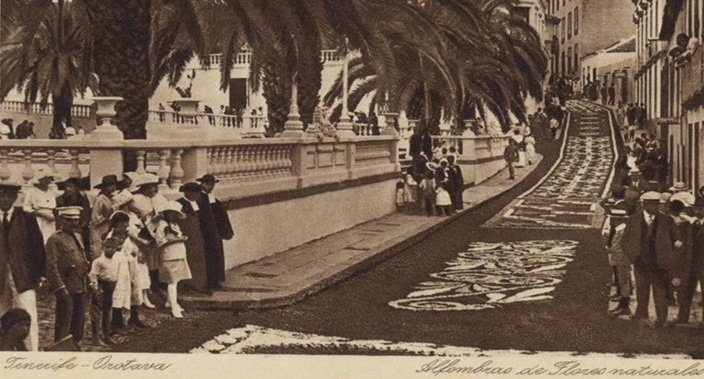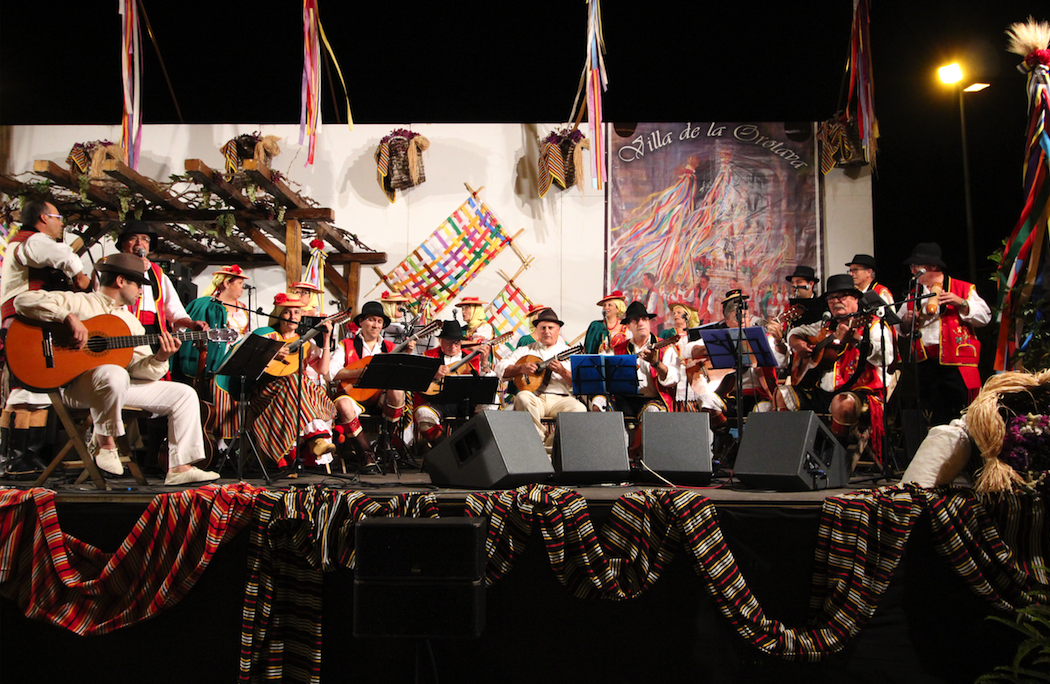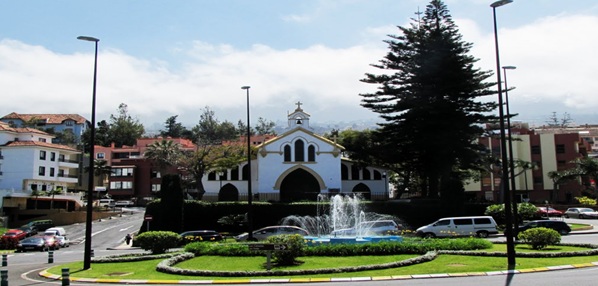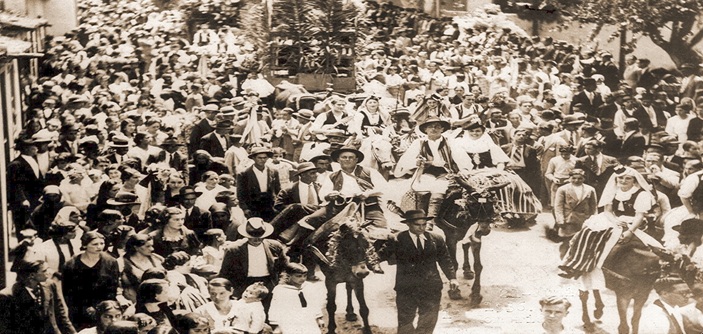
THE PATRON SAINTS’ FESTIVITIES IN VILLA DE LA OROTAVA
PATRON SAINTS’ FESTIVITIES: Corpus Christi and ‘San Isidro Labrador’ Pilgrimage.
The first festivity held in La Orotava, still called La Aorotava, took place on 22nd June 1516. It consisted of a few public amusements in order to celebrate the accession of King Carlos I of Castille to the throne. Since then, the Holy Week and the Corpus Christi celebrations were introduced and both were implanted in the region shortly after the consummation of the conquest. They had special roots in the municipality and already in 1576 the Corpus Christi procession was consolidated in La Orotava, and besides parading the Sacred Form by the streets of the Historical Centre, altars were mounted in the frontispieces of the main mansions.
The Patron Saint’s Festivities in Villa de La Orotava are celebrated during four days, a long weekend that begins on Thursday and ends on Sunday, but not on any Thursday, since tradition has established a chronological criterion. Problems of religious nature led Bishop Vicuña to sign a Solomonic document: from 1700 onwards, the feast would be celebrated eight days before the Corpus Christi, with the procession leaving from the church ruled by the nuns of the San Nicolás convent (nowadays, the post office building).
Trying to recover the former splendour of the Corpus Christi festivities in La Orotava, Doña Leonor del Castillo, who had married Don Juan Monteverde, born in La Orotava, had the brilliant idea of making a flower tapestry in front of their house at Colegio street. The first one was made in 1847, a simple work of art that reproduced a geometric drawing of baroque style, made with flower petals covering the cobbled road. This initiative surprised the town society so much that soon found many adepts among the local aristocracy. Thus, the artistic principles of this floral manifestation were established, becoming a tradition that has made La Orotava famous around the world.
In the year 1882 a new version of the flower tapestries originates. A peasant surnamed Valladares, who worked for the Monteverde family, devised a system to create a new type of flower tapestries by taking a barrel hoop as a mould, which he filled with flower petals. This technique was known as ‘corrido’, or, as he would say, ‘saragata’.

These ephemeral tapestries have no other purpose than being trampled by the bearers of the processional float that carries the Corpus Christi. From then until today the route of the procession is practically the same: Patricio García square, Colegio street, Carrera street, Tomás Pérez and Inocencio García streets. All these streets are covered with a total of 34 flower tapestries, occupying about twelve hundred square meters. Floral tapestries and ‘corridos’ alternate, combined with the great volcanic sand tapestry of the Town Hall Square, Guinness Record in 2007, as the largest natural sand painting in the world, with 859.42 m2.
In Villa de La Orotava only a Tapestry uses the Mount Teide National Park volcanic sands for its preparation. It is the Tapestry par excellence, which since 1919 is made in the esplanade provided by the Town Hall Square. This tapestry has become, over the years, the most qualified expression of the La Orotava tapestry art, since it concentrates all human and artistic efforts as the culmination of the liturgical act. When, in 1919, a large area was available in front of the Town Hall, the religious and civil authorities agreed to modify the original procession to make a stop on a new tapestry that would be made there. The square had already been used to honour the visit of the Spanish Navy (1905) and to welcome Alfonso XIII (1906). The space was given to the most prestigious ephemeral tapestry artist of the moment, Felipe Machado, who accepted with great pleasure. Mr. Machado began his task by using flowers to make the Tapestry, as it was traditional, but little by little and due to the wide surface that he had to cover, he favoured the use of volcanic sands and other materials (logs, seashells ...). The flowers disappeared, substituted by volcanic sands, with a wide range of colours that are used in pure state, or mixed with each other. The period of execution has been extended and now the beginning of the preparation and sketches is proposed months before the celebration of the Corpus Christi. La Orotava ephemeral tapestry art has experienced a continuous conquest in the fields of aesthetics and although it always moves within the canons of Baroque art, the avant-garde details have marked a positive evolution.
The Corpus Christi processional float known as ‘Las Andas del Corpus Cristi’ is another treasure to be highlighted in this celebration. In the day it belonged to the Dominicans, and it was comprised of a canopy to which an ornamental pavilion was added in the year 1750. In this silver pyramid we must highlight the filigree stands made by the local goldsmiths José Domingo Acosta and Felipe Acosta Bencomo, father and son. This structure is crowned with the baroque monstrance made in Cordoba in 1768 along with the central piece made of gold and encased with emeralds, diamonds and rubies to place the Sacred Form in a very prominent point. The musical accompaniment surrounds the celebration in a very difficult to express atmosphere of ostentation, a unique experience that can only be enjoyed in the streets of the historic centre. If you have the chance to experience it you will surely want to witness it again.
VILLA DE LA OROTAVA Great Traditional Dance.
On Friday, during the Festivities, the ‘magos’ dance is celebrated in La Orotava, whose inhabitants wear their traditional peasant costumes and enjoy music and traditional gastronomy. The term ‘magos’ is used because it is an expression that, in the Canary Islands speech, means ‘peasant’. This dance is celebrated outdoors, in the main streets and squares of the Historical Centre of the town.

LIVESTOCK EXHIBITION
On Saturday morning the traditional livestock exhibition is celebrated. In this ancestral event, tradition, folklore and religiosity mix. It is not a mere concentration and exhibition of livestock, as a blessing ceremony of fields and livestock is also carried out. The images of ‘San Isidro Labrador’ and ‘Santa Maria de la Cabeza’, the patron saints, are carried in procession from the Calvario Sanctuary to the fairgrounds, on the shoulders of the members of the ‘Labradores’ confraternity, dressed in typical costumes and carrying decked poles. After the celebration of the Eucharist, blessing of the fields and livestock, and once the farmers and peasants act of exaltation is over, the return procession will take place.
THE ASCENT OF THE SAINT
The prelude to the San Isidro Pilgrimage is popularly known as ‘the Ascent of the Saint’, a celebration that becomes more and more popular every year in La Orotava. On the eve of the main day of the festivities, hundreds of La Orotava inhabitants accompany the patron saints on Saturday night, from the Calvario Sanctuary to the Parish of Nuestra Señora de la Concepción. The transfer is denominated ‘Ascent of the Saint’ and it ends with a pyrotechnic exhibition.
LA OROTAVA “ROMERÍA” (POPULAR PILGRIMAGE)
La Orotava's agricultural tradition, an ancestral vocation that links its inhabitants with the agricultural tasks and the moments of gratitude along with the moments of production, made farmers and herders pay homage to the saint they had taken as benefactor: ‘San Benito Abad’. This saint, linked to the Mesa family, had his first hermitage at the northern end of the town, where the convent of Santo Domingo was built years later, which still remains.
This festivity was called the Peasants’ feast, because they were the ones who celebrated and thanked their patron saint for the great benefits they obtained year after year with their crops. The birth of the municipality of La Orotava and the obtaining of the title of ‘Villa’ were the reasons that made ‘San Isidro Labrador’, canonized in 1622, be proclaimed as the main protector of the town, due mainly to its popularization throughout Spain after Madrid adopted him as Patron. The image of San Isidro was placed in a small and modest building located next to the La Orotava main Calvary and very soon, in the middle of the seventeenth century, his festivity began to be celebrated, having as central act a popular pilgrimage in which the images of ‘San Isidro Labrador’ and his wife ‘Santa Maria de la Cabeza’ were paraded in the end.

The first pilgrimages were celebrated in the surroundings of El Calvario, in the historical path of Las Dehesas: later on, in Llano de San Sebastián until the Augustinian church of Nuestra Señora de Gracia and after the religious celebration, the ceremony of blessing of the livestock took place. The current pilgrimage with San Isidro to the Calvario Sanctuary dates back to 1846, when the Mayor Alonso de Ascanio y Molina introduced this popular feast when he returned from his trip to Madrid, where he had the opportunity to see the pilgrimage of the Spanish capital. He organized one that he completely paid for and then handed it over to the Town Council for its continuation in the following years. The present pilgrimage is based on a format acquired in the year 1936, under the care and organization of the Taoro cultural lyceum of this town and, from then on, decked carriages, spree bands, music players and singers were added to the parade.
This is the maximum manifestation of the cheerful and colourful Canary Islands’ popular folklore, congregating thousands of visitors every year, who rejoice to the sound of ‘isas’ and ‘folías’, popular dances and songs from the Canary Islands, of recognized international prestige, as the popular lyrics say: ... ‘because of San Isidro the pilgrimage, the most beautiful feast in the Canaries is’
We could summarize this idea with the words of the great French naturalist Sabino Berthelot to his friend Charles Bollen, after enjoying the pilgrimage of La Orotava in 1853:
‘All the towns of the Valley come to it to the sound of the guitars and their songs. I entered the town surrounded by a bustling joy, among groups of fun-loving peasants and girls with happy faces. Garlands, pennants and flags fluttered everywhere, and I passed under green triumphal arches. And what am I going to tell you about the Feast? Twenty pages would be few.
In addition you could not smell the sweet fragrance of the flowers, nor this vivifying air that surrounds us. You could not hear that rumour that is mixed with cries of joy and popular songs. You must have heard all this, have seen it to understand the drunkenness that produces such a show, a mixture of simplicity and luxury, peasant costumes and elegant attire ... ‘
In 1892, these two independent feasts, which had managed to stand out with respect to the resto of them, were unified. We are talking about the Corpus Christi (which would then be called the Flower Festival) and the San Isidro Labrador Pilgrimage. In 1965 they received the title of Holidays of Tourist Interest and in 1980 they were reclassified as of National Tourist Interest.
The dates of celebration of the Patron Saint Festivities in Villa de La Orotava in the next ten years will be the following ones:
2017: 22nd JUNE 22 – 25th JUNE
2018: 7th JUNE – 10th JUNE
2019: 27th JUNE -30th JUNE
2020: 18th JUNE - 21st JUNE
2021: 10th JUNE – 13th JUNE
2022: 23rd JUNE – 26th JUNE
2023: 15th JUNE – 18th JUNE
2024: 6th JUNE – 9th JUNE
2025: 26th JUNE – 29th JUNE
2026: 11th JUNE – 14th JUNE
2027: 3rd JUNE – 6th JUNE
Enjoy them!












































